Official Name:
St. Robert is the name of the village where this shower fell.
Location:
St. Robert is close to Sorel, on the south shore of the St. Lawrence River, Quebec, Canada.
Fall or Find:
Fall
Date:
14 June 1994, 8:00 p.m. local time.
Mass Recovered:
The fragments found totalled 25.4 kilograms.
Number of Fragments:
It is estimated that hundreds of fragments fell that evening in June, but so far only 20 have been recovered.
Strewn field:
The strewn field measures 8 by 3.5 kilometres. There are probably still some fragments buried in the cornfields that cover three quarters of the area. The main mass may have fallen in the delta of the Yamaska and Saint François (St. Francis) Rivers.
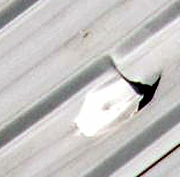
Enlargement
Barn roof hit by a fragment of the St. Robert chondrite. |
|
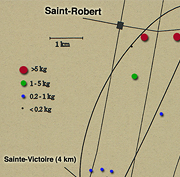
Enlargement
The strewn field of the St. Robert shower measures 8 by 3.5 kilometres. |
|
Crater:
The four biggest fragments left holes 50 centimetres wide by 50 centimetres deep.
Circumstances:
On June 14, 1994, around 8:00 p.m., thousands of people in Quebec, Ontario, and the northeastern United States observed a fireball travelling at 70 000 km/h enter the atmosphere. The accompanying explosions could be heard as far away as Ottawa. In Montréal, buildings and windows shook.
The first meteorite was recovered shortly after the shower. The Forcier brothers heard something fall near the family home. Once outside, they saw curious cows gathered around a hole in the meadow-a hole that was actually a small crater. At the bottom of this small crater lay a cold black stone weighing 2.3 kilograms. Farther away, another fragment hit the aluminum roof of a barn, leaving a noticeable dent.
History:
In the days following the fall, the race for meteorites began in St. Robert! Residents, scientists, and collectors combed fields throughout the area.
To make it easier to find meteorites, one resident used an unusual detector. Pierre Sasseville used a ski pole without its basket to probe holes in the fields. Instead of bending down to dig with his hand in each hole, he used the pole to poke around and only bent down if he hit something hard. Because there are few stones in the region, his detector was quite effective. Using it, Mr. Sasseville discovered several fragments of the St. Robert meteorite.
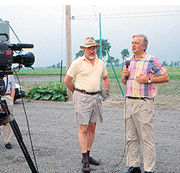
Enlargement
Journalist Réal D'Amour interviewing Richard Herd of the Geological Survey of Canada. |
|
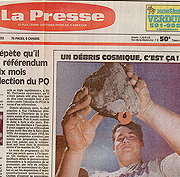
Enlargement
Front page of the Montréal newspaper La Presse, Thursday, June 16, 1994-36 hours after the fall. Stéphane Forcier is holding up the first fragment discovered. |
|
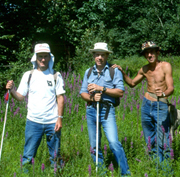
Enlargement
Damien Lemay (amateur astronomer), Alan Hildebrand (geologist), and Pierre Sasseville (St. Robert resident), looking for fragments. All three meteorite hunters are holding ski poles without baskets. |
|
Type:
Stony meteorite
Class:
Ordinary chondrite
Group:
H5
Composition:
The grey-white interior of the meteorite has small pieces of white metal and bronze in it. The St. Robert meteorite is an H5 chondrite. It contains about 30% olivine and pyroxene chondrules, 10% iron, and 5% troilite.
Analysis of the St. Robert meteorite shows that the chondrules and minerals reacted chemically with one another. The meteoroid must have been subjected to slight heating, setting the stage for differentiation.
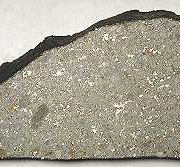
Enlargement
Slice of the St. Robert meteorite with fusion crust. |
|
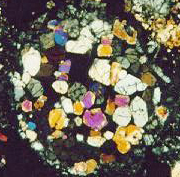
Enlargement
One of the meteorite's chondrules, seen through a microscope under polarized light. |
|
Scientific contribution:
Because the fall was recent, various technologies could be used to analyze it. Two satellite systems observed the St. Robert meteoroid when it entered the atmosphere. According to calculations, its aphelion (the point of its orbit farthest from the Sun) was located between the orbits of Mars and Jupiter-in other words, in the asteroid belt.
Measuring isotopes and trace elements in the meteorite enabled scientists to determine the size of the parent meteoroid before it entered Earth's atmosphere. It had an initial diameter of 80 to 120 centimetres and a mass between 1 000 and 2 000 kilograms.
Comments:
The event in St. Robert is exceptional because in Canada, only 12 observed falls have led to the recovery of meteorites since 1887. It was the first observed meteorite shower in eastern Canada and the first stony meteorite found in Quebec. This fall is also special because scientists were able to carry out the analyses rapidly-less than 68 hours after the fall.
Part of the Planétarium's collection:
Yes